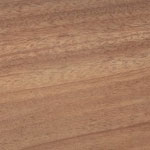Serving Upstate NY—VT—MA • For selections & prices, CALL or EMAIL US
Khaya (African Mahogany)
Grades & Properties of Wood Flooring —
Exotic Species
Scientific Name:
Khaya ivorensis
Other Common Names and Related Species:
- African Mahogany
- Akuk
- Bandoro
- Benin Mahogany
- Bisselon
- Bitehi
- Diali
- Iri
- Iri Kiree
- Khaya Mahogany
- Lagos Mahogany
- Ogwano
- Senegal Mahogany
Shop online now for Khaya Flooring »
Origin:
Central Africa.
Janka Hardness: 830
Khaya (or African Mahogany) has about the same hardness as American Cherry. It should not be confused with Genuine Mahogany, which comes from Brazil and tropical America.
Grades of Khaya Flooring:
Almost all Khaya flooring is Clear grade, which is chosen for its unique red color. It bears a close resemblance to Genuine Mahogany.
Khaya Flooring Dimension Specifications:
Some African Mahogany flooring is milled in Africa because it is more cost-effective to ship finished material than raw lumber. However, some is also milled in the U.S. and Canada with the same specs. Lengths of the Khaya flooring bundles are 7 feet so they can easily fit into 8-foot-wide steel shipping containers. Some is milled in the U.S. and Canada by large mills. All pre-milled products are tongue-&-groove and end-matched (tongue-&-grooved on the ends of the boards). Moisture content ranges from 6% to 8% for quick acclimation. The average length of the flooring pieces is usually about 3 feet and ranges from 1 to 7 feet. Almost all imported flooring that is found is in 7-foot bundles, with widths available from 2¼″ to 5″. If a long or wide plank floor is desired, raw lumber must be obtained and the flooring must be milled here in the United States. Typically, the lengths can develop up to 12 feet. However, the cost can be double that of the pre-milled stock because of waste and labor costs in the United States. Also, raw lumber is relatively expensive.
Flooring Availability:
Khaya flooring is available prefinished or unfinished in solid form for nail-down applications and in engineered form with a veneer top layer for application over concrete. African Mahogany is an uncommon species in comparison with most hardwood flooring. There is a moderate amount of African Mahogany in Africa, and it is not endangered. However, less logging, stricter regulations, and a slower American economy have limited commodities and caused slightly higher prices of this product in this country.
Finished Floor Appearance:
A Clear grade Khaya floor will have a reddish light brown appearance, similar to that of genuine Mahogany. The grain patterns of Khaya are interlocked. Oil-based finishes allow Khaya flooring to age to a deeper dark color. Water-based finishes are recommended to keep the natural color longer.
Flooring Durability and Stability:
Khaya flooring is somewhat soft and moderately resists denting and traffic wear. It has similar hardness to some North American floors like Cherry. Because of its low density, it can swell with moisture if not acclimated properly. Khaya flooring is very heavy, weighing about 3 pounds per square foot.
Workability of Khaya Flooring:
Being moderately soft, African Mahogany works with little difficulty with both hand and power tools. When installing the flooring, it is best to use a manual nailer, but staples and pneumatic nailers can be used. It holds screws well but glues well, and stains and polishes to a very attractive finish. Professional sanding and finishing is recommended. This wood is very resistant to decay and insects; these resistant properties may contribute to a possible allergic response to the dust. To avoid a possible allergic reaction to the material, wear a dust mask and long-sleeve shirt when working with Khaya.
Principal Uses of Khaya Flooring:
African Mahogany flooring is used in high-end residential and commercial applications for a dramatically elegant floor. It is also used for color-contrasting borders and medallions.





